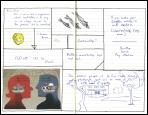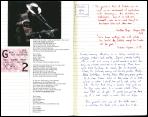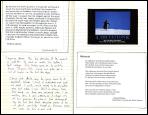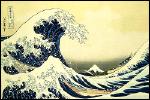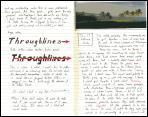Over the last few years I've spend hundreds of hours making collages of various kinds. I've also made an effort to familiarize myself with the work of other contemporary collage artists, and to archive their work on tumblr and Pinterest, as for example on
this board, which has nearly 5000 examples. I've been making an effort lately to try to articulate some of what goes on in my head as I'm working. This is what I've got so far.
Considerations:
• You are always working in two dimensions within a rectangle. It's a grid. You can work against the grid, with it, or, most often, in some combination of both.
• Variables include the shapes (both positive and negative), the colors, the number and the relative sizes of the elements.
• In terms of number of elements in the collage, there are challenges at both ends of the spectrum. I've seen very interesting collages that are composed of only two elements. On the other hand too many elements can threaten to overwhelm the eye.
• Text can be included as a formal design element, as a vehicle for the introduction of a concept, as another kind of contrast to color and shape, or to signal seriousness of purpose or lack thereof.
• Colors can be coordinated or contrasted.
• Juxtaposition can go in many ways: one on top of another, edge to edge, overlap, or with space in between.
• There is an inherent element of randomness and playfulness in collage. There are tradeoffs. Things that don't work for me: 1) complete chaos on the one hand, 2) overdetermined, message-oriented, pictorial stuff, 3) incongruous combinations: eagle heads on cacti, cars with boobs, people with apples where their heads should be, etc. I like to work in a zone of semi-abstraction, one the elements of the collage create a field of energies that are like a nonverbal conversation. I don't generally like explicitly narrative collages, but I do like collages which function, as in the best abstract art, as independent universes whose idiosyncratic rules distantly echo our own, and which invite the viewer to think about what those rules might be in this particular case.
• There is a very large intuition quotient in the creation of a collage. You put it together piece by piece, and every part of the process—the selection of the elements, the decision whether to tear or cut or both, the placement of each piece, the configuration and extent of negative space—is made holistically and without explicit strategic planning. Sometimes, very rarely, I will lay out the major elements of the collage first before I start gluing, mostly to make sure that the last pieces don't look just stuck on top. But more often I start, as I do when I'm drawing abstracts, by gluing down a single piece somewhere on the paper and then simply building from that, linking the additions via placement, color, and shape as I go along. Given a pile of materials—and of course there is always an element of selection, however arbitrary, in the makeup of the pile—it is not completely off the mark to say that once I start working the collage builds itself.
• On the other hand, it could also be said that every collage is in effect a kind of oblique self-portrait at a particular moment in time. I'm the one who has collected and selected the materials. I'm the one who has decided, even if the decisions have been intuitive rather than strictly rational, what goes where. And each collage reflects my inner sense of what juxtapositions feel right and complete one another. The collages I make now don't look much like the collages I used to make. I'm a different person; they're different too.
• The ecology of collage: there's something inherently satisfying about up-cycling old, often discarded materials in order to make something new. One of the great masters of twentieth-century collage, Kurt Schwitters, was explicit about this:
I could see no reason why tram tickets, buttons, and old junk from attics and rubbish heaps should not serve well as materials for paintings; they suited the purpose just as well as factory-made paints… it's possible to cry out using bits of old rubbish, and that's what I did...
Example:
This collage, which I completed in January, consists of eight elements placed in a roughly square configuration. They do not "mean" anything, either individually or taken together. (I make it a point of practice NOT to make collages which have a paraphrasable content or message. Any attempt to "interpret" them is more or less doomed by design and intention.) Which is not to say that there isn't anything to think about here, but that the thinking I am trying to generate is intuitional, nonlinear, nonverbal. I am going by feel. I put things together so that I like the way they look. But I am also interested sensing the energies that are set into motion by particular juxtapositions, and by the irregularities and disharmonies, as for example between the rectangular, gridlike elements and the soft, irregular torn edges of some of the shapes.
I have tried with some consciousness to provide lines for the eye to walk. There is for example, an arm which moves the eye up from the landscape, pointing to the people on the bridge, the same people which the eye of the bearded man on the old coin seems to be looking at. There are patterns of rectangles, but there are patterns of disruption in and among the rectangles. In the upper right corner there is a rectangular piece of paper holding a triangular shape framing a half-circle on which is superimposed a full circle, holding a face, looking at the faces of the other people on the walkway, facing us. The checkerboard is one sort of landscape plan, a playing field, which echoes the actual field below it. The upraised hand and finger belong to Klay Thompson of the Golden State Warriors basketball team, photographed at play on a different plane. The checkerboard in the center is a kind of abstraction and simplification of the lines the collage as a whole, a kind of playful mirror-in-miniature: the rigorous grid-like logic of the former both echoing and contrasting with the loose connectedness of the grid-like elements in the latter.
The whole collage is made of pieces of paper that 1) are in a certain tonal range of brown, grey, and black, 2) have been selected by me in a preliminary way at various times
previous to the construction of the collage, and in a very specific way
during its construction, and placed in square 6" x 6" format that was a given before any of the arrangements began. (That particular format is one of my favorites, both because I like the paper the
pads are made of, and because the size constraint feels about right to me for the materials I most often use. It's also a convenient format when you are working, as I most often am, in a limited space.)
Perhaps it's only because I have taken the time to work all this out in words, but I have a particular fondness for this collage. Every time I make a collage it's a crapshoot. I'm just playing with shapes and colors and juxtapositions, and sometimes they come together in ways that are emotionally and intellectually satisfying to me. As I have said above, each collage is a world of its own, with its own internal harmonies and disharmonies, its own logic, its own set of unarticulated and preferably unarticulatable overtones or reverberations. Sometimes, it just feels right.


